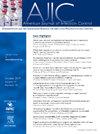Prevalence of infection and reinfection among health care workers in a hospital of Northern China between BA.5/BF.7 and XBB.1.5 wave
IF 3.8
3区 医学
Q2 INFECTIOUS DISEASES
引用次数: 0
Abstract
Background
To analyze the epidemiological characteristics of the SARS-CoV-2 infection and reinfection associated with the emergence of Omicron variant in Healthcare workers (HCWs).
Methods
We enrolled 760 HCWs who received 2-4 vaccination doses of COVID-19 and followed by BA.5/BF.7 and/or XBB.1.5 breakthrough infections between December 2022 and July 2023. Serum sample from each individual were collected approximately 1,3 and 6 months after last exposure. IgM, IgG and Total antibodies against SARS-CoV-2 were measured by chemiluminescent immunoassay. Meanwhile, we created an Enterprise WeChat link for HCWs to self-report SARS-CoV-2 infections, symptoms and post COVID-19 conditions.
Results
Our study revealed that the reinfection rate among HCWs reached 26.1%. The main symptoms were fever (91.2% vs 60.1%), cough (78.8% vs 58.0%), and sore throat (75.4% vs 59.6%) during infection and reinfection in Omicron BA.5/BF.7 and XBB.1.5 wave, and the interval for reinfection ranged from 91 to 210 days (median 152). Fatigue (23.6%), memory loss (18.8%) and coughing (18.6%) were the most prevalent long COVID symptoms, with a higher prevalence among female HCWs.
Conclusions
HCWs reinfection with SARS-CoV-2 causes milder symptoms, but high reinfection rate and short intervals. Strengthen infection prevention and control is crucial to mitigating infection risk and improving health services.
华北某医院医护人员在BA.5/BF.7波和XBB.1.5波之间华北某医院医护人员的感染率和再感染率。
背景:在COVID-19大流行期间,医护人员(HCWs)作为前线响应者发挥着至关重要的作用。本研究旨在分析医护人员首次感染 SARS-CoV-2 和再次感染与 Omicron 变种出现相关的流行病学特征:我们招募了760名在2022年12月至2023年7月期间接种过2-4剂COVID-19疫苗并随后发生BA.5/BF.7和/或XBB.1.5突破性感染的HCW。每个人的血清样本都是在最后一次暴露后大约 1、3 和 6 个月采集的。通过化学发光免疫测定法测定 SARS-CoV-2 的 IgM、IgG 和总抗体。与此同时,我们还创建了一个企业微信链接,供HCW自我报告SARS-CoV-2感染、症状和COVID-19后的情况:结果:我们的研究显示,HCW 的再感染率达到 26.1%。在 Omicron BA.5/BF.7 和 XBB.1.5 波感染和再感染期间,主要症状是发烧(91.2% 对 60.1%)、咳嗽(78.8% 对 58.0%)和咽喉痛(75.4% 对 59.6%),再感染间隔时间从 91 天到 210 天不等(中位数为 152 天)。乏力(23.6%)、记忆力减退(18.8%)和咳嗽(18.6%)是高危职业工人最常见的长期 COVID 症状,女性高危职业工人的发病率更高:结论:HCW 再感染 SARS-CoV-2 后症状较轻,但再感染率高且间隔时间短。加强预防策略、保护和培训对于降低高危卫生工作者的感染风险和改善卫生服务至关重要。
本文章由计算机程序翻译,如有差异,请以英文原文为准。
求助全文
约1分钟内获得全文
求助全文
来源期刊
CiteScore
7.40
自引率
4.10%
发文量
479
审稿时长
24 days
期刊介绍:
AJIC covers key topics and issues in infection control and epidemiology. Infection control professionals, including physicians, nurses, and epidemiologists, rely on AJIC for peer-reviewed articles covering clinical topics as well as original research. As the official publication of the Association for Professionals in Infection Control and Epidemiology (APIC)

 求助内容:
求助内容: 应助结果提醒方式:
应助结果提醒方式:


